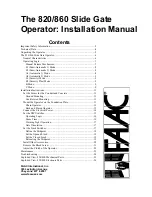
3
3.
Only qualified personnel should install this
equipment. Failure to meet this requirement could
cause severe injury and/or death, for which the
manufacturer cannot be held responsible.
4.
The installer must provide a main power switch that
meets all applicable safety regulations.
5.
Clearly indicate on the gate with a minimum of 2
warning signs (visible from either side of the gate)
that indicate the following:
•
The gate is automatic and could move at
any time, posing a serious risk of
entrapment.
•
Children should not be allowed to operate
the gate or play in the gate area.
•
The gate should be operated only when it
is visible to the operator and the when the
area is free of people and obstructions.
6.
It is extremely unsafe to compensate for a damaged
gate by overtightening a clutch or increasing
hydraulic pressure.
7.
Devices such as reversing edges and photocells
must be installed to provide better protection for
personal property and pedestrians. Install reversing
devices that are appropriate to the gate design and
gate application.
8.
Before applying electrical power, be sure that the
voltage requirements of the equipment correspond
to your supply voltage. Refer to the label on your
operator system.
Use
1.
Use this equipment only in the capacity for which it
was designed. Any use other than that stated should
be considered improper and therefore dangerous.
2.
When using any electrical equipment, observe
some fundamental rules:
•
Do not touch the equipment with damp or
humid hands or feet.
•
Do not install or operate the equipment
with bare feet.
•
Do not allow small children or incapable
persons to use the equipment.
3.
If a gate system component malfunctions, turn off
the main power before making any attempt to repair
it.
4.
Do not attempt to impede the movement of the
gate. You may injure yourself as a result.
5.
This equipment may reach high temperatures
during operation; therefore, use caution when
touching the external housing of the operator.
6.
Learn to use the manual release mechanism
according to the procedures found in this in-
stallation manual.
7.
Before carrying out any cleaning or maintenance
operations, disconnect the equipment from the
electrical supply.
8.
To guarantee the efficiency of this equipment, the
manufacturer recommends that qualified personnel
periodically check and maintain the equipment.
U.L. Class and FAAC Operator
Model
Duty Cycle
Typical Use
Class I: Residential Vehicular Gate Operator
402 746
422 750
412 760
630
Limited duty
•
Home use
•
Small apartment building, for example, up to 4 units
in a building, with limited public access
Class II: Commercial/General Access Vehicular Gate Operator
400 640
620
Continuous duty
•
Apartment buildings
•
Very public access
Class III: Industrial/Limited Access Vehicular Gate Operator
400 640
620
Continuous duty
•
No public access
Class IV: Restricted Access Vehicular Gate Operator
620 640 Continuous
duty
•
Prison rated security




































